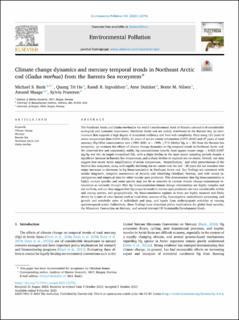| dc.description.abstract | The Northeast Arctic cod (Gadus morhua) is the world's northernmost stock of Atlantic cod and is of considerable ecological and economic importance. Northeast Arctic cod are widely distributed in the Barents Sea, an environment that supports a high degree of ecosystem resiliency and food web complexity. Here using 121 years of ocean temperature data (1900–2020), 41 years of sea ice extent information (1979–2020) and 27 years of total mercury (Hg) fillet concentration data (1994–2021, n = 1999, ≥71% Methyl Hg, n = 20) from the Barents Sea ecosystem, we evaluate the effects of climate change dynamics on Hg temporal trends in Northeast Arctic cod. We observed low and consistently stable, Hg concentrations (yearly, least-square means range = 0.022–0.037 mg/kg wet wt.) in length-normalized fish, with a slight decline in the most recent sampling periods despite a significant increase in Barents Sea temperature, and a sharp decline in regional sea ice extent. Overall, our data suggest that recent Arctic amplification of ocean temperature, “Atlantification,” and other perturbations of the Barents Sea ecosystem, along with rapidly declining sea ice extent over the last ∼30 years did not translate into major increases or decreases in Hg bioaccumulation in Northeast Arctic cod. Our findings are consistent with similar long-term, temporal assessments of Atlantic cod inhabiting Oslofjord, Norway, and with recent investigations and empirical data for other marine apex predators. This demonstrates that Hg bioaccumulation is highly context specific, and some species may not be as sensitive to current climate change-contaminant interactions as currently thought. Fish Hg bioaccumulation-climate change relationships are highly complex and not uniform, and our data suggest that Hg temporal trends in marine apex predators can vary considerably within and among species, and geographically. Hg bioaccumulation regimes in biota are highly nuanced and likely driven by a suite of other factors such as local diets, sources of Hg, bioenergetics, toxicokinetic processing, and growth and metabolic rates of individuals and taxa, and inputs from anthropogenic activities at varying spatiotemporal scales. Collectively, these findings have important policy implications for global food security, the Minamata Convention on Mercury, and several relevant UN Sustainable Development Goals. | |
